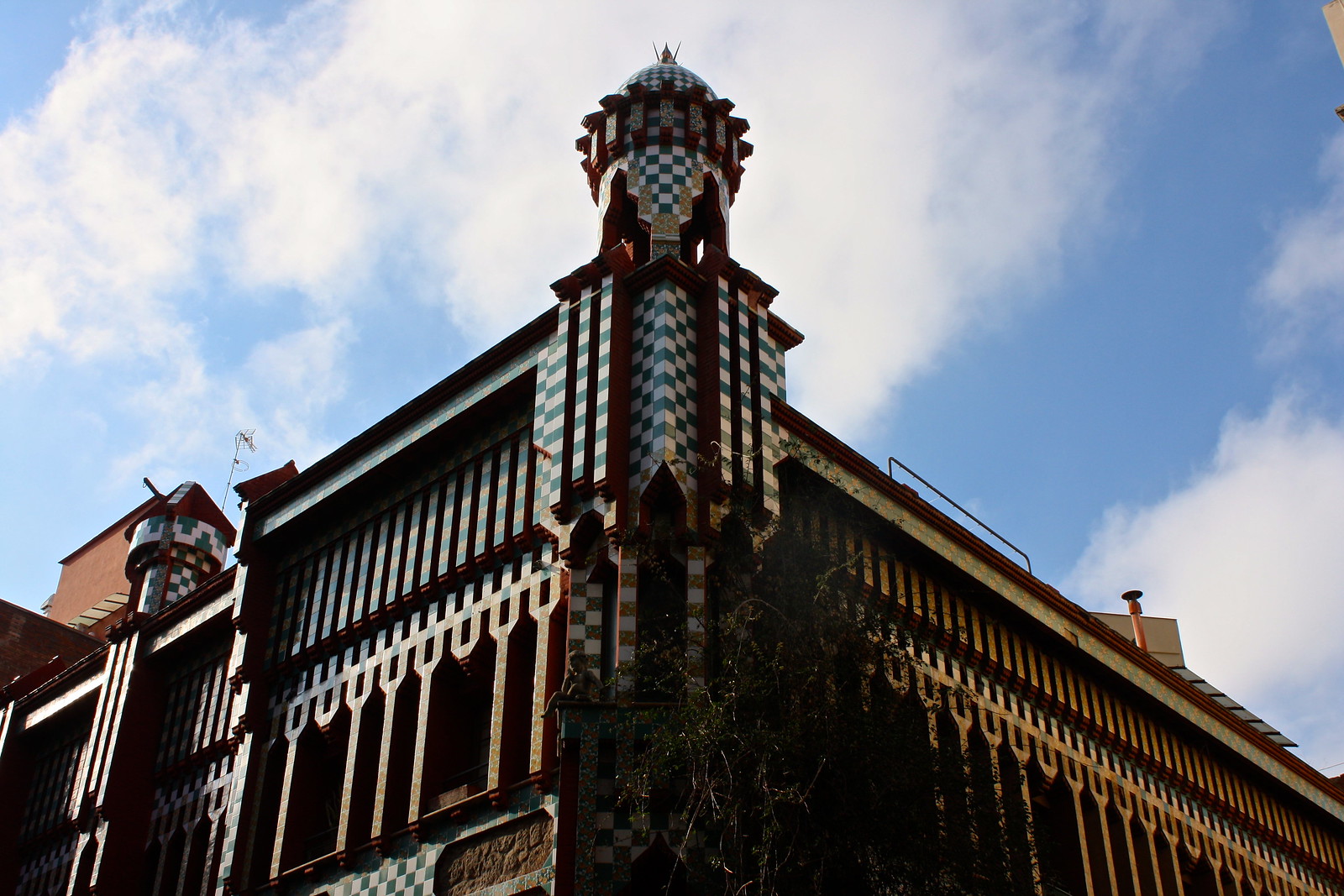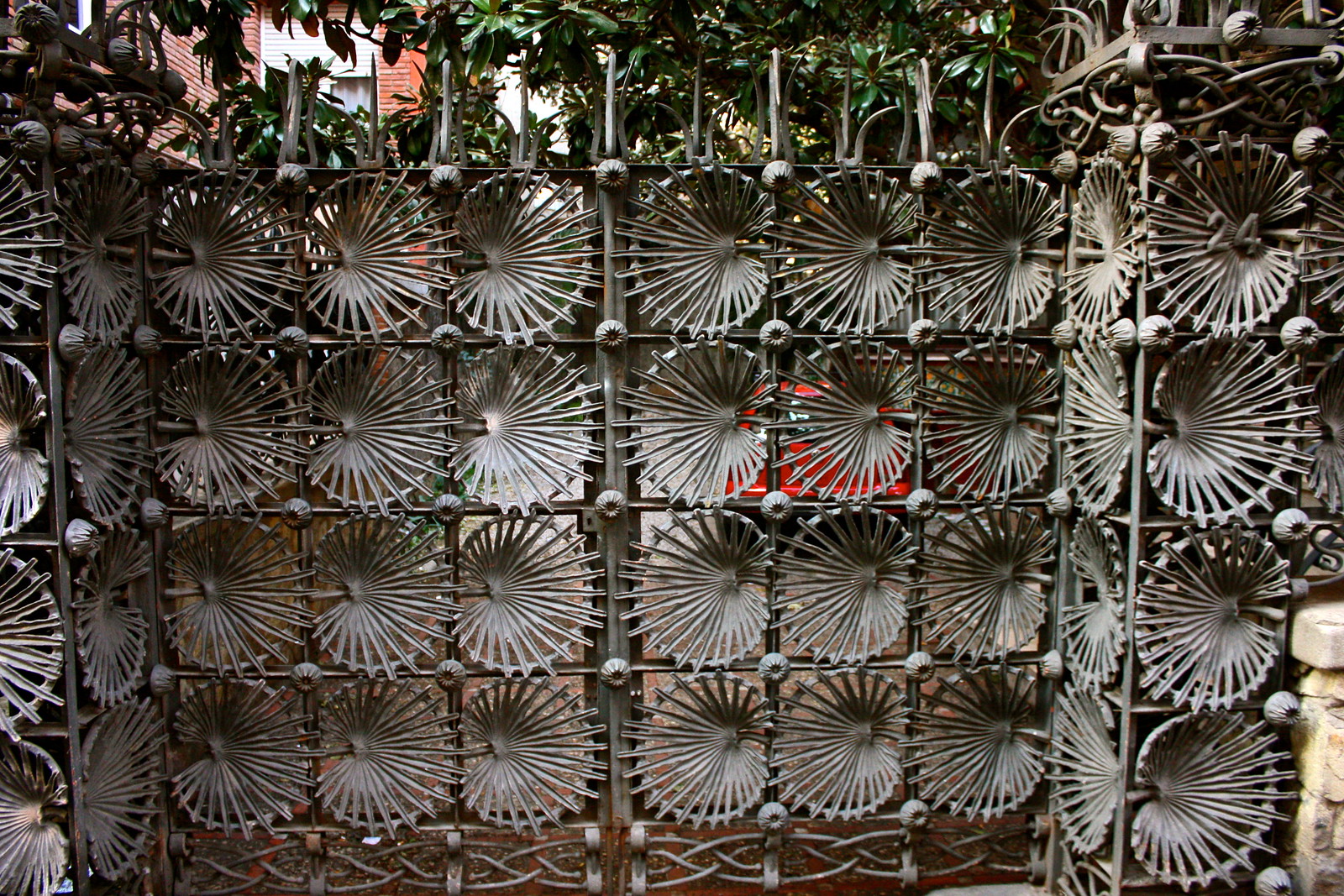Gaudí Week #7: Casa Vicens in Barcelona, Spain
This week on the blog, I’m celebrating works by the famous turn-of-the-century Catalan architect Antoni Gaudí, who designed everything from churches to mansions to public parks. This post is the last installment in a seven-part series; check out the introduction here!
This little-seen house is visited by none but the most dedicated Gaudí fans (i.e., yours truly), so when I managed to turn onto C/ Carolines during a sunny Barcelona siesta, I ran into only a handful of fellow travelers, some toting guidebooks and others cameras. I lingered for a few minutes, snapped some pictures, and headed back down a major street to get some croquetas for lunch.
Casa Vicens is—surprise, surprise—still a private home, and so tourists have to be content to admire its architecture from behind iron grillwork. Finished in 1889 at the request of Manuel Vicens, a man in the brick and tile business, the house has subtle nods to Vicens’ industry: warm, red bricking and happy white-and-green tiles that give the fortress-like house a pixelated look.
As Gaudí’s first work, his trademark style isn’t clearly evident yet here, but Moorish elements abound without falling into the exoticist trap of Revivalism: you can catch hints of the Alhambra in the arches and columns, and the overhanging roofs are reminiscent of the flourishes found over entrances to Moroccan homes. Seashells (palm fronds?) populate the iron gate to the property, reminding us of Gaudí’s lifelong fascination with the shapes of nature.
Currently it’s up for sale—to the tune of 30.000.000€. Yes, that’s thirty million euros. Think of it less as a piece of property, though, and more as a work of art, especially since Gaudí designed everything from the doors to the toilet seats (probably). It’s still on the market, and I wonder if some philanthropic business or foundation might take it over, clean it up, and re-open it to visitors as the next Casa Batlló, La Pedrera, or Palau Güell. Or maybe it will escape becoming a museum for a few generations, remaining just as the architect intended it to be—a home.
If you’ve ever been to Barcelona, have you ever seen Casa Vicens? Do you think it should become a museum or stay a private home? Comment below!
 |
| Façade of Casa Vicens |
This little-seen house is visited by none but the most dedicated Gaudí fans (i.e., yours truly), so when I managed to turn onto C/ Carolines during a sunny Barcelona siesta, I ran into only a handful of fellow travelers, some toting guidebooks and others cameras. I lingered for a few minutes, snapped some pictures, and headed back down a major street to get some croquetas for lunch.
Casa Vicens is—surprise, surprise—still a private home, and so tourists have to be content to admire its architecture from behind iron grillwork. Finished in 1889 at the request of Manuel Vicens, a man in the brick and tile business, the house has subtle nods to Vicens’ industry: warm, red bricking and happy white-and-green tiles that give the fortress-like house a pixelated look.
 |
| Gate, Casa Vicens |
As Gaudí’s first work, his trademark style isn’t clearly evident yet here, but Moorish elements abound without falling into the exoticist trap of Revivalism: you can catch hints of the Alhambra in the arches and columns, and the overhanging roofs are reminiscent of the flourishes found over entrances to Moroccan homes. Seashells (palm fronds?) populate the iron gate to the property, reminding us of Gaudí’s lifelong fascination with the shapes of nature.
Currently it’s up for sale—to the tune of 30.000.000€. Yes, that’s thirty million euros. Think of it less as a piece of property, though, and more as a work of art, especially since Gaudí designed everything from the doors to the toilet seats (probably). It’s still on the market, and I wonder if some philanthropic business or foundation might take it over, clean it up, and re-open it to visitors as the next Casa Batlló, La Pedrera, or Palau Güell. Or maybe it will escape becoming a museum for a few generations, remaining just as the architect intended it to be—a home.
How to get there
Casa Vicens is house Nº 24 on C/ Carolines in the Gràcia district. Take the L3 (green line) on the Metro and get off at the Fontana stop. Head north on C/ Gran de Gràcia and turn left at C/ Carolines. If you reach Av. Príncep d’Astúries, you’ve gone too far.If you’ve ever been to Barcelona, have you ever seen Casa Vicens? Do you think it should become a museum or stay a private home? Comment below!